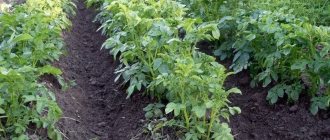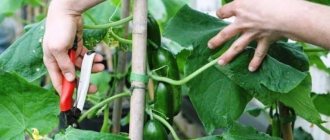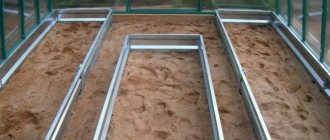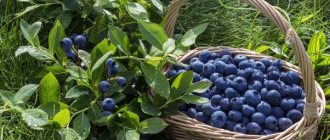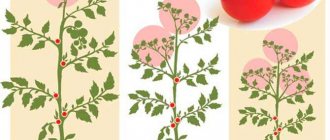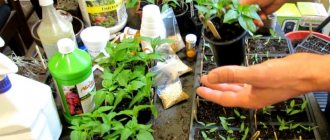To obtain a good harvest, it is important to shape the bell pepper. Read more in the article.
According to experienced summer residents, the process of plant formation is the main way to increase the yield and size of future fruits. Novice vegetable growers extremely rarely use this technique, believing that the plant will give a good harvest without the formation procedure, and that it is possible to get by only with watering and fertilizing. However, shaping is not a single procedure involving cutting and pinching. This process has a large number of stages and includes many techniques.
Read another article on our website on the topic: “What can you cook from bell peppers for the winter?” . You will find recipes for preparing sweet bell peppers for the winter. You will also find tips on drying, freezing, and pickling. This article also contains the best recipes for preparing stuffed vegetables, fried bell peppers, in tomato-garlic sauce, caviar, lecho, and adjika from bell peppers for the winter.
A pepper bush, formed according to all the rules, will have a beautiful appearance and will be able to please the vegetable grower with a good harvest. How to do this correctly, read on.
Varieties of bell pepper: features of their formation
Bell pepper
When starting to form bell pepper, it is worth considering the characteristics of each variety. Here is a list of them and the features of their formation:
- Tall pepper : when shaping, it is necessary to carry out the pinching procedure, as well as cut off shoots that are unnecessary and that interfere with growth.
- Medium-sized pepper : it is important to remove fruitless side shoots. This will increase the light supply and allow air to circulate around the plants more well.
- Low-growing and dwarf peppers : these types do not require special shaping. When growing them, it will be enough to remove weak shoots without fruits.
Pinching the crop must be done very carefully. Follow all rules.
Basic shaping techniques
When forming sweet pepper bushes, 3 fundamental techniques are used: pinching, pruning, pinching. When performing each procedure, rules are used.
Stepsoning
This technique involves cutting off additional lateral processes that grow in the axils of the leaves. If you leave all the additional branches, then the plant will spend a lot of energy on their growth, and not on the formation of vegetables and their ripening.
Rules for forming bell peppers
In order to reap a rich harvest of bell peppers in the future, you need to know the rules of formation:
- Low-growing varieties must be allowed to grow freely.
- There should be few ovaries, then the size of the pods will increase.
- Pinching increases the speed of ripening.
- Do not leave stepchildren until the first fork is pecked.
- Remove all shoots directed into the bush.
- When forming a bush, it is worth leaving 2-3 trunks.
- Frame shoots should grow freely.
- The blind branches above the ovaries must have 1-2 leaves to receive nutrition.
- Tall varieties need to be tied up (each shoot separately).
- The fruits on the frame branches should be distributed evenly.
The shoots should be removed when this can be done without injuring the bush itself.
Useful tips for gardeners
Experienced gardeners share useful secrets and subtleties of growing with beginners, like how to pinch sweet peppers:
- Pepper prefers group plantings. This is how plants develop better.
- Powerful branches that do not have inflorescences and ovaries must be cut or torn off.
- Mature plants, as a rule, need a garter.
- To avoid mass infection of seedlings, the tool used for pinching is processed after each bush.
- Cut stems and leaves are removed from the beds to prevent pest damage.
Pinching allows knowledgeable gardeners to achieve a high-quality pepper harvest in a short time. Beginners often start by pinching some of the plantings so as not to harm all the planted plants. With experience, they can evaluate how effective this procedure is.
Methods for shaping bell peppers
There are several different ways to shape bell peppers:
- Removing inflorescences : growing to 20-25 cm , the skeletal stem begins to branch. Buds grow in the bifurcation area. They must be removed for the further, correct branching process.
- Pinching shoots : a proper bush should have a stem and a couple of strong shoots coming from the inflorescence. Other branches should be removed by pruning.
- In one stem : when the bushes are located at a small distance from each other, the crops are able to unite into one stem. In such a situation, it will not be possible to harvest from large bushes, so they need to be discharged to improve ventilation and nutrition of each plant.
If the first two methods are clear, you need to remove the buds or pinch the shoots. The process of formation “ into one stem ” is not always clear, especially to novice gardeners. It looks like this:
- The first stage should begin when branches arise.
- All growing shoots are pinched; only the main stem on which the ovary is located needs to be preserved.
- Fresh forks that appear on the skeletal stem should also be removed.
- After 12 fruits ripen on the bush, pinch the crown.
Method for forming bell peppers
There is one more method - “in two stems”. This is the most common forming option. As a result, the plant should have a V-shaped design . This method allows you to collect about 25 fruits from 1 plant. The process has the following sequence:
- The skeletal growth of the first order grows into 2 processes of the second order. The strongest shoot is left untouched. It will support other processes located above and is considered skeletal. Leave buds with leaves on this shoot. The second process is usually weaker. Pinch it off, keeping the fruit with leaves.
- The main shoot of the second order is divided into two processes, which will have a third order. It is also necessary to isolate the skeletal process from these branches. He will develop and grow well. In the axils of the leaves of the main shoot, remove all the stepsons. In addition, all yellowed leaves should be removed from the main branches. Pinch the weakest third-order shoot at the top, where the flower bud is located. It is imperative to leave one leaf, which will nourish all the ovaries.
- A similar process is carried out with the first-order skeletal process of the second branch (1st fork). The bush is divided into two stems. If you keep two side shoots on the trunk instead of one, then you will get 4 main branches. One needs to be cut off.
- After 20-26 fruits ripen on the bush, cut off the tops of the plant.
- After cutting off the top, the nutrients will be redirected to the young ovaries.
Another popular way of forming “in three stems” :
- To grow three-stem peppers, you need to have a large greenhouse, but this method will bring the richest harvest.
- With this planting option, each bush receives maximum nutrition and lighting.
Choose the most suitable method for yourself. The formation stages are described below. Read on.
Stages of formation of bell pepper: diagram
When forming a plant using the stem method, you need to install trellises so that branches of all orders are attached to the transverse fasteners. Here's the diagram:
Stage of formation of bell pepper
Remember: A large number of fruits can break thin branches.
Low-growing, hybrid and weakly branching varieties do not require formation.
Worth knowing:
- Perform processing when the first branches appear.
- In cases where the number of sprouts that appear is more than 3 , the excess ones are removed.
- If the number of shoots on a branch is less than 3 , then you need to leave the lower shoots on the skeletal stem. When they grow, keep the strongest one and remove the rest.
- After a fork appears on the stems of the first order, all weakened, thin shoots are cut off and one, stronger one is left.
- The cut should be repeated for the main branches of new orders until 25 to 30 fruits .
- Then cut off the top of the plant to remove the growing point. This will give the bush the opportunity to form a rich harvest.
On the main stems of all orders, new leaves and ovaries may soon appear. They need to be cut off gradually. First, those leaves that shade the ovaries must be removed. This procedure must be repeated until the bush grows to a height of one meter. So that there is no more growth, and the beneficial substances go to the lower fruits and ovaries, the top is cut off. In 1.5 months. Before harvesting fruits, the top of the main branches of all orders must be cut off so that beneficial microelements are redirected to the lower fruits.
Worth knowing: On formed bushes of plants, about 20-25 large, thick-walled fruits are usually preserved. With the onset of autumn, a large number of small ovaries and fruits will appear on unformed bushes.
Remember:
- When growing peppers in the garden - in the open air, and not in greenhouse conditions, you need to form only tall varieties.
- For a medium-sized species, only barren shoots with stepsons need to be removed to provide the bushes with sufficient oxygen and light.
- The low-growing species does not need to be processed.
Important: All inward growing, broken and crooked processes are subject to the removal procedure. Bushes of medium-sized and low-growing peppers need pinching of the central shoots to enhance lateral branching.
Stages of formation of bell pepper - sequence:
- As soon as the pepper gets stronger and reaches a height of 25-30 cm , it is necessary to remove all the primary buds.
- In addition, cut off the buds on the side shoots, this will stimulate the growth of additional branches. The seedlings will begin to bush.
- All subsequent shoots should be formed in the same way: remove the stems and leave 3-5 branches .
- On the skeletal process, before the first fork, remove shoots and leaves.
- All main trunks should be pruned at the point of growth after a large number of fruits have appeared.
- Perform the final pruning procedure several weeks before the end of fruiting.
The total number of fruiting shoots should not be more than 4-6 pieces, and 15-25 .
What seeds can be collected for next year?
Although the formation of seeds is still far away, at the stage of formation of the first flower you already need to think about them. It is advisable to collect seeds from varieties, not hybrids, of peppers. Hybrid varieties exhibit varietal characteristics only in that year's harvest. The next time you plant, the seeds will produce completely different peppers than you received this season. Their quality, shape, color, size will differ greatly from this year’s harvest, and not for the better. Indeed, in the second generation, recessive genetic traits will already be clearly expressed. But if you want to see this for yourself, then for the sake of experiment, you can collect seeds from hybrids and try to plant them next year.
Greenhouse growing of bell peppers: principle
When transferring seedlings to a greenhouse, they must be planted in such a way that there is always space to increase the volume by several bushes. The planting scheme for the most bushy species can be 5-6 pieces per square meter. With average bushiness, plant 6-8 bushes per meter.
Greenhouse growing of bell peppers
The principle of greenhouse formation of bell pepper is to rid the plant of barren shoots:
- After the plant has taken root at the planting site, it must be constantly inspected and treated for parasites.
- Barren shoots growing on the trunk before the first fork begins should be removed to provide the bushes with good lighting and air circulation.
Greenhouse pinching of bell pepper
Pepper shoots that appear after branching are called lateral shoots . These processes are skeletal. Each of these shoots initially grows as a central stem with leaves. Subsequently, new shoots, called stepsons . These shoots must be removed by pinching.
When to start forming
Peppers are very rarely grown directly from seeds; first, they take care of the seedlings. Therefore, even before the seedlings begin to be transferred to the greenhouse, they begin to form young bushes. The first procedures for removing stepchildren begin when the peppers reach a height of 20 cm.
On a note!
Space is left around the planted plants for the development of bushes. No more than 5-6 pieces are planted per square.
The first formation procedures are performed before planting, and then they are regularly pruned and excess shoots are removed after the seedlings have taken root in the new location.
Mistakes when forming and growing bell peppers
The formation of a bell pepper bush actually begins with the planting process. A gardener must know not only how to prune or pinch a bush, but also how to properly plant, fertilize and water plants. Here are the mistakes when forming and growing bell peppers:
- Violation of planting deadlines : pepper seedlings need to be planted only after the threat of return of spring frosts has disappeared, otherwise the plant may die. According to reviews from experienced vegetable growers, in the middle zone, seedlings begin to be planted in open ground in late May - early June. You can plant seedlings in closed structures already at the end of April, and in heated greenhouses - in mid-March.
- Excessive nutrition with fertilizers : at the beginning of the growing season, like other nightshade crops, pepper needs nitrogen fertilizing. However, you should not overdo it with fertilizers, because overfeeding leads to excessive formation of useless green mass. You need to water the seedlings once, after rooting. As a fertilizer, you can use a weak solution of urea (one dessert spoon per 10 liters of water) or a weak solution of slurry (1:10).
- Violation of the temperature regime : if the bushes have many peduncles, but ovaries do not form at all, then the plant is experiencing problems with pollination. This can occur due to high air humidity, for example, in a greenhouse, as well as sudden temperature fluctuations. Heat and cold are equally harmful to plants. It is necessary to reduce watering, constantly ventilate closed structures during hot weather and heat during cold weather. It is necessary to treat the seedlings with preparations that improve the appearance of ovaries.
- Improper watering : both deficiency and excess of water in the soil are equally harmful. When watered with ice water or the soil dries out, the ovaries and flowers begin to fall off en masse. Plants need to be watered with settled water, heated once every 3-7 days, when 2-3 cm of the top layer of soil has dried.
- Inadequate nutrition : A lack of minerals such as calcium, magnesium and potassium combined with cold weather can lead to the formation of fruit rot. Ripening fruits on diseased plants begin to rot at the point where the stalk attaches. During cold summers, you need to use foliar feeding with the addition of phosphorus-potassium fertilizers.
- Cross-pollination of sweet and savory varieties when they are in the same greenhouse.
- Long exposure of seeds in potassium permanganate : this substance removes all harmful microorganisms from this material well. However, too strong a solution and too long exposure of the seeds can lead to combustion of the material.
Experienced vegetable growers advise using a solution of no more than 0.5 percent strength and keeping the seeds in it for no longer than 25 minutes. To prepare such a solution, you need to dilute 0.5 teaspoon of manganese in 600 milliliters of water.
Pests of bell pepper
Pests of bell pepper
Dangerous pests for bell pepper are whiteflies, thrips, and May beetle larvae. Greenhouse plants are most often attacked by aphids. Fertilizing and adding potassium-phosphorus fertilizers to the soil are very helpful in controlling pests. In addition, drugs created on the basis of quickly decomposing biological toxins or viruses that kill parasites have a good effect. Such substances are safe for humans and plants. Spraying crops to get rid of pests is best done exclusively in the morning.
- Bell pepper is a very smart crop.
- Therefore, by carefully observing it, you can quickly understand that the plant is sick.
- The main signs of the disease are: discoloration and yellowing of leaves, fading.
- A timely reaction and subsequent care of the plant will allow it to quickly recover and continue to bear fruit.
During flowering and budding, you need to add plant ash in the amount of 1-2 cups per linear meter (before watering). You can additionally treat plants with drugs that increase stress resistance and immunity, for example: Zircon, Ecoberin, Silcom. This procedure should be performed in the morning, having prepared the solution in advance, following the instructions on the package.
Proper care of peppers after formation
Bell pepper when properly formed
Formation is a serious stress for the plant due to the fact that many leaves and shoots are removed from it. After this process, the plant requires high-quality and proper care to restore and continue growth:
- First of all, the pepper must be tied to a support so that its branches do not break under the weight of the fruit.
- Constantly spray the crop with warm water.
- Water in the early morning or late evening.
- The following waterings must be combined with the process of applying fertilizer.
By following the advice and recommendations of experienced gardeners, you can avoid the most common mistakes when growing bell peppers. Good luck!
Recommendations from experienced vegetable growers
If the pepper was formed according to certain rules, then all that remains for the vegetable grower is to continue to care for it in accordance with the requirements of the crop. At the same time, we must not forget that any manipulation with the plant causes discomfort to it. After pinching, pinching and trimming the pepper, no additional procedures should be carried out. Bushes need time to recover. To reduce the risk of bush death after crown formation, it is recommended:
- remove buds, leaves and tops of shoots at different times with an interval of 5-7 days;
- do not water, spray or fertilize newly pruned bushes (an injured plant is not able to absorb the substances it needs, excess moisture can damage the roots, and the process of rotting will begin).
Pruning is carried out only in dry weather, early in the morning or in the evening after sunset. It is especially important to follow this recommendation for those owners of greenhouses who open them for the summer, almost completely removing the film.
The formation of pepper bushes is considered one of the important agrotechnical procedures carried out in order to accelerate the growth and ripening of fruits, as well as the most convenient placement of a large number of plants in a limited area.



